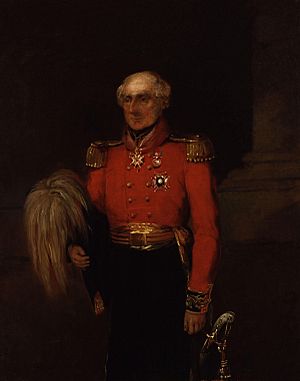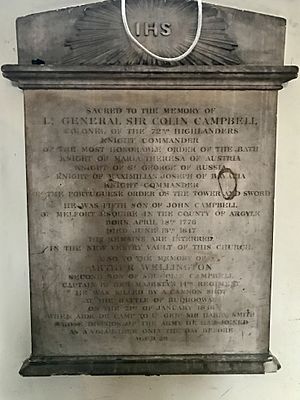Colin Campbell (British Army officer, born 1776) facts for kids
Quick facts for kids
Colin Campbell
|
|
|---|---|

Sir Colin Campbell by William Salter
|
|
| 8th Governor of British Ceylon | |
| In office 15 April 1841 – 19 April 1847 |
|
| Preceded by | James Alexander Stewart-Mackenzie |
| Succeeded by | James Emerson Tennent (Acting governor) |
| 17th General Officer Commanding, Ceylon | |
| In office 16 April 1841 – 28 January 1847 |
|
| Preceded by | Robert Arbuthnot |
| Succeeded by | William Smelt |
| 25th Lieutenant-Governor of Nova Scotia | |
| In office 1834–1840 |
|
| Preceded by | Thomas Nickleson Jeffery acting |
| Succeeded by | The Viscount Falkland |
| Personal details | |
| Born | 18 April 1776 |
| Died | 13 June 1847 (aged 71) |
| Military service | |
| Allegiance | |
| Branch/service | |
| Rank | Lieutenant general |
| Unit | 78th (Highlanders) Regiment of Foot |
| Commands | General Officer Commanding, Ceylon |
Sir Colin Campbell (born April 18, 1776 – died June 13, 1847) was a brave British Army officer. He later became a colonial governor, helping to lead British territories. He is remembered for his courage in many battles and his important work in different parts of the world.
Contents
Military Career
Colin Campbell was born in Scotland. He was the fifth son of Colonel John Campbell. From a young age, Colin showed a daring spirit. When he was 16, he ran away from school. He joined a ship sailing to the West Indies. His brother, Patrick Campbell, found him there and brought him home. His parents then allowed him to join the navy. In 1793, he became a midshipman on an East Indiaman ship. He made several voyages.
Early Military Service
In 1795, Campbell became a lieutenant in the Breadalbane Fencibles. This was a type of local army unit. He fought with them in the Irish Rebellion of 1798. In 1799, he joined a West India regiment as an ensign. He worked as a brigade-major in St. Vincent in 1800. In 1801, he joined the 78th Foot regiment. This regiment was stationed in British India.
Fighting in India
Campbell joined his new regiment in India. He fought alongside Arthur Wellesley in the Second Anglo-Maratha War. This war was against Indian rulers. Campbell showed great bravery in battle. He led his troops during the attack on Pettah of Ahmednagar in 1803. Wellesley was very impressed by his actions. He quickly made Campbell a brigade-major.
Campbell served in this role at the Battle of Assaye. He was badly wounded there. Two or three horses were killed under him during the fight. He also fought at the Battle of Argaum and the storming of Gawilghur. When Wellesley left India, he highly recommended Campbell. He suggested Campbell to his brother, Richard Wellesley. Richard then made Campbell his aide-de-camp (a personal assistant to a high-ranking officer).
Service with Wellesley in Europe
In 1806, Campbell returned to England with Lord Wellesley. Sir Arthur Wellesley asked him to be brigade-major for his troops. Campbell went with Wellesley to Hanover. He also joined the Copenhagen Expedition in 1807. His actions at the battle of Kioge were very noticeable.
In 1808, Sir Arthur Wellesley made Campbell his senior aide-de-camp. This was when Wellesley led an army to Portugal. Campbell was sent home with news of the victory at battle of Roliça. However, he heard the sounds of battle and returned to fight. He was present at the Battle of Vimeiro. He was promoted to major in 1808.
Peninsular War
Campbell continued to serve in the Peninsular War in Portugal and Spain. He fought in many important battles. These included the Battle of Douro, battle of Talavera, and battle of Busaco. He was promoted to lieutenant-colonel in 1810. He was also at the Battle of Fuentes de Oñoro and Battle of Salamanca.
In 1812, Campbell became an assistant quartermaster-general. This was at Wellington's special request. He held this role until the end of the war. He was present at the storming of Badajoz. He fought in ten major battles. For his bravery, he received the Peninsular Gold Cross and six clasps. These clasps showed how many important battles he had been in.
After the Peninsular War
In 1814, Campbell was promoted to colonel. He also became a captain in the Coldstream Guards. He was made a Knight Commander of the Bath (KCB). This was a very important honour. He also received an honour from Portugal. In 1815, he joined the Duke of Wellington's staff. He was present at the famous Battle of Waterloo. He stayed in Paris with Wellington's army until 1818.
Wellington thought Campbell was a great soldier. He once joked about Campbell's French skills. Campbell later became a major-general in 1825. He commanded the southern district for several years.
Colonial Governor Roles
Campbell became lieutenant-governor of Tobago in 1828. Later that year, he became Lieutenant-Governor of Portsmouth. In 1833, he was appointed lieutenant-governor of Nova Scotia.
In 1840, he was promoted to be the governor of Ceylon (now Sri Lanka). He served there from 1839 to 1847. During this time, the Duke of Wellington wrote to him. Wellington said, "We are both growing old; God knows if we shall ever meet again. Happen what may, I shall never forget our first meeting under the walls of Ahmednuggur." This showed their strong friendship. Campbell returned to England in June 1847. He died on June 13, 1847, and was buried in St. James's Church, Piccadilly. A memorial to him is also in the church.
Honours and Awards
Sir Colin Campbell received many honours for his military service.
- He was a Knight Commander of the Bath (KCB).
- He was also a Knight of Saint George of Russia.
- He was a Knight of Maximilian Joseph of Bavaria.
- He was a Knight Commander of the Portuguese Military Order of the Order of the Tower and Sword.
- He was a Knight of the Military Order of Maria Theresa of Austria.
He received the Waterloo Medal for fighting at the Battle of Waterloo. He also earned the Army Gold Medal for the Peninsular War. This medal had clasps for battles like Talavera, Busaco, Fuentes de Oñoro, and Badajoz. He had six more clasps for battles like Salamanca, Vitoria, the Pyrenees, Nivelle, Nive, and Toulouse. Only a few other officers, like Wellington, had more clasps than him. This shows how many important battles he fought in.
Family Life
Sir Colin Campbell married Jane Harnden. They had seven children together.
- Patrick Fitzroy Wellesley (1808–1875) became a colonel in the army, just like his father.
- Arthur Wellington (1815–1846) was killed in battle during the First Sikh War.
- Frederick Archibald (1817–1874) became a vice-admiral in the Royal Navy.
- Maria Louisa married the Hon. Edmund Phipps. She was the mother of future ambassador Sir Constantine Phipps.
Portraits
You can see portraits of Sir Colin Campbell in several art collections.
- The National Portrait Gallery has three works featuring him. These include a sketch by Thomas Heaphy and an oil painting by William Salter.
- He also appears in a group portrait by Thomas Heaphy. This painting shows the Duke of Wellington giving orders to his generals.
- Drawings of him are also in the British Museum and the Scottish National Portrait Gallery.
- He can be seen in William Salter's large group portrait called Waterloo banquet at Apsley House. This painting is in the Wellington Museum.


